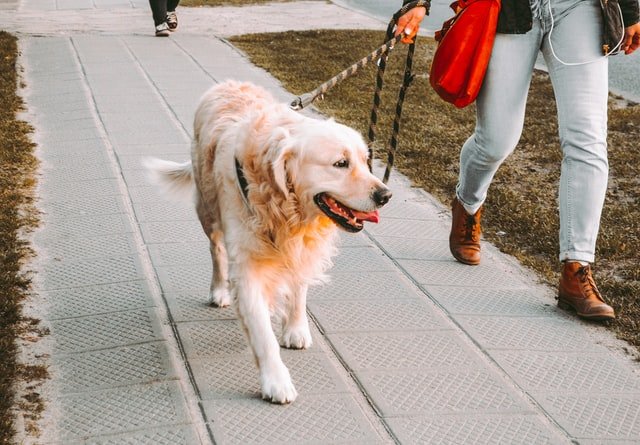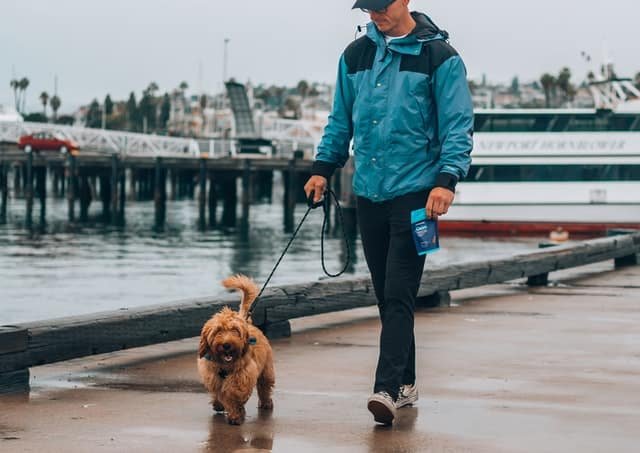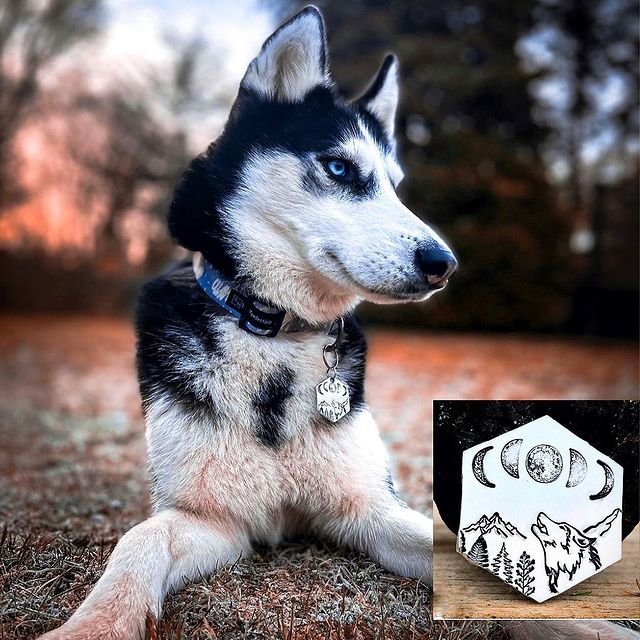Going for walks is fundamental in a dog’s daily routine. It helps them with socializing, being mentally stimulated, improving digestive and emotional health, and also, increase their muscle function. The benefits of walking your dog are endless. Following some basic training ensure walking your dog is as enjoyable for both of you as it really should be.
Taking your dog out for a walk is not always a walk in the park (pun intended). Without proper training and equipment, it looks more like pulling, yelling, and frustrated sighs. In worse scenarios, you can get tripped over by your dog, dragged down hills, or even sprain your back.
To teach your dog how to walk, there’s one thing you have to keep in mind—patience is the key to success. It takes an ample amount of time, commitment, love, and patience to walk your pet in the proper way.

Dogs have a short attention span because they are easily distracted by noise, the things they see and smell; especially if it’s a new neighborhood. Hence, the process of training them may seem monotonous and even tedious. However, when done right, the results will leave you smiling with pride. And those daily walks that seemed impossible become the highlight of your day.
In this article, we’ll be sharing with you extensive tips on how to walk your dog, the equipment you need to make the experience a breeze, and mistakes to avoid when on your daily strolls with your furry friends. This is a dog walking 101.
Loose Leash Walking
Loose training is the most pleasant way to walk your dog. It is a way of walking with your dog on a leash without any tension.
But when exactly is right to start walking your dog on a leash? The best time to start walking your dog is when they are around 4 months old. But before they get to that age, you can focus on foundational exercises that they will need to learn. Some of them include: teaching them how to follow food movements, teaching them how to answer cues as conditional reinforcers, teaching them how to answer their names, and other trick training.
These exercises form the building blocks that will help your buddy become successful when you start leash training fully.
Preparing to take your dog for a walk
walking equipment you’ll need
On a walk with your furry friend, you need some essential tools to make the experience smooth and jolly for everyone. Fair warning, these tools may not make you look like the most fashionable person on the block, but you’ll have a well-trained dog walking by your side. So, totally worth it.

Here’s a list of tools you’ll need:
- Leash
During your strolls, the first thing you need to do is establish your control over your pet. This is important not just for you, but for your dog who is extremely distracted by the new sights. A leash is one of the fastest ways of establishing control. However, when it comes to choosing a lease, your dog size, weight, behavior, and environment.
- Leash Size:
An ideal leash is usually between 4 – 6 feet long in order to maintain control. At first glance, there isn’t much between the two ranges but in different scenarios, they play major roles.
Say you live in a busy area, with fast-moving cars and traffic. For your little pup’s safety, it would be wiser to get a 4-foot leash. With it, you can have a firmer grip and reduce the amount of space your dog gets to explore (into danger!).
If you stay in a quieter neighborhood, a 6-foot leash is a great idea. It gives your dog that space to sniff out his surroundings and catch up on the latest sights.
- Leash Comfortability
Another thing to also look out for when selecting this tool is how comfortable it is. Experts suggest getting a sturdy leash with a couple of knots sewn into the length. The knots help you with grips when your dog becomes unruly.
If you or your dog gets irritated easily, it is advisable to get a cotton leash because it is durable and softer than other materials.
If you go on walks around the beach regularly with your dog, getting a polypropylene leash is a great choice. Why? Because the material doesn’t absorb water as much as cotton or nylon does. Another con to this leash is that it doesn’t stretch out when wet.
If you’re also concerned about heaviness, choose a nylon leash.
Pro Tip: Go for a thicker leash if you have a large dog (especially if your furry friend chews and/or pulls). For smaller dogs, a less bulky rope leash would be a great choice.
You could also opt for a waist leash. With this type of leash, your hands are free and you can solely focus on training your dog. However, the force of your dog’s pulling and jerking could result in injuries to you. Ultimately, the choice of your leash depends on how well you know your dog and the level of training they have received.
- Harness or Collar
Just like the leash, the harness or collar provides you with control and helps curb your dog’s pulling.
According to experts, a harness is more preferred to collars because of the possibility of a collar strangling your pet. Some dogs are more prone to windpipe trauma, and the collar pressing down on their throats when they pull on the leash could choke them.
A harness, on the other hand, clamps on their shoulders and chest and reduces any form of yanking. Particularly, a front-clip harness blocks your dog’s power and directs them towards your direction when you tug the leash.
However, with the number of collars and harnesses available for sale in the market, it is wise to seek the opinion of your vet before making a final choice.
- Clickers
A clicker is a cheap and effective way of communicating with your buddy and marking good behavior. The ‘click’ sound could be used as a signal to your dog when he does what you told him to.
Just like the affirmations, ‘yes’ and ‘good doggie’, this method is consistent and doesn’t leave your dog confused as to what you want.
- Treats
Who doesn’t like a ‘good job’ when you do something well? Well, your dog wants that too. Remember to take along with you some treats to reward them when they behave well.
Pro-Tip: Combine a couple of high-quality treats with some plain yet enjoyable treats. You can hand out the plain treats when they do something you want, but when they do something that makes you especially proud, dish out the high-quality ones. That way, they’ll be eager to please you.
Pro Tip: Instead of feeding your dog a full meal before the walk, spread their meal throughout the day, and in between their training sessions.
- Treat Bag
Your treat bag is a small pouch you can store your goodies in.
- Poop Bag
No one likes stepping on poop. No one! So, it’s only kind to your neighbors if you take a poop bag along to clean up after your pet. Don’t let the poop decompose or ‘fertilize’ their yard.
Stuff a few in your bag and when they get filled, dump them at the nearest garbage can. If none is within reach, you could wait till you get home before disposing of the bag.
deciding on the best time to walk your dog
Based on your dog’s size, age, and energy level, you can choose how many times in a day you want to hit the street and at what time.
It is best to go for a walk early in the morning or later in the evening when the streets are less crowded and offer minimal distractions to your pet.
Avoid walking your dog in the afternoon sun because the pavements would be too hot for his feet.
Pro Tip: Place your hand on the pavement for 5 seconds. If you have to remove it because it’s too hot, it’s going to be a pain for your dog to walk on.
Picking a side
Picking a side for your dog to walk on may not seem necessary but it is useful to consider it.
By default, most dog owners walk their dogs and heel them on the left side. This is because a larger population of the community is right-handed; and for convenience’s sake, they can use their right hand to perform other activities such as holding a coffee, unlocking the car with their keys, or picking a phone call.
Some exceptions do exist in the case of owners with medical issues on their left side.
However, there is no rigid rule for you to follow. Whatever side you prefer is entirely up to you. The only thing you need to do is to be consistent to avoid confusing your dog.
Nine tips for walking your dogs

Start Your Training Indoors
Long before taking your pup for a walk, it’s great to start leash training them indoors. That way, there are minimal distractions for honking cars, other people, or dogs to vie for your dog’s attention.
Choose a location in your home where your dog is excited about hanging out and start practicing walking. It could be the backyard or the garage. Spend quality time potty training him and structuring play dates.
Walk In Front
There are several reasons why your dog would prefer to walk ahead of you.
For one, they are digitigrades (animals that walk on their toes) and walk a lot faster than humans. They love the outdoors and are easily distracted by the new sights. Another reason is that they have a lot of pent of energy from lack of exercise and mental stimulation.
This results in them running ahead and displaying some unruly behavior.
Walking in front of your canine buddy sends a message that you’re in charge and gives them a sense of direction to follow.
Take Structured Walks
In easy vocab, structured walks are walks geared towards a laser-focused purpose. These walks are more than taking a breather, exercising, or releasing energy. It would require a lot of attention from you (as a dog parent) and a lot of patience and thinking from your dog.
During structured walks, your dog just walks. Avoid stopping to greet people. or looking around at distractions. Make sure you can focus on your dog and your surroundings. For this part it’s best to avoid headphones or being in conversation with someone. Pretty straightforward.
What structured walks does is that it reinforces your leadership to your dog and makes them follow you easily. Although it might seem to limit, dogs also thrive when boundaries are placed.
Use The Pressure-Release Formula
When walking your dog, the most common mistake people make is to use the leash as a handle instead of a communication tool.
Dogs instinctively want to move against pressure (the leash) instead of with it. That’s how their body naturally responds. So, yanking on the leash in an opposite direction just leads to a tug-of-war between you two. And with a big strong dog at the other end of the leash, the chances are that you’ll get hurt. Teaching the pressure-release helps with this.
The way to accomplish this is to make sure there is no tension on the leash under normal walking conditions. When your dog starts to pull or move out of range, give the leash a small, fairly sharp tug, and release. When they obey, mark the behavior with a ýes’ or ‘good boy’ and reward him with a treat.
If you’re consistent and clear with the little sharp tugs and slack movements, your dog will quickly learn how to communicate with you.
Pro Tip: When your dog starts pulling, do not pull the leash upward.
Pay Attention To Your Dog’s Languages
Too many times, we teach a dog to understand what we’re trying to communicate but never take out time to understand their language. Frankly, it’s not fair.
Just like humans, your dog speaks in several ways—body language, facial expressions, and sounds. With this, you can quickly diffuse unruly behavior or remove triggering objects.
On a walk with your buddy, typically look out for:
- Growling
- Whining
- Perked ears
- Howling and ‘Whale’ Noises
- Intent Staring
- Sneezing and Yawning
- Panting
- Tail Movements
Set A Time Frame For The Walks
Instead of setting a route or a specific destination to get to, set a timer and walk back and forth. It might be a fifteen or twenty minutes walk but it’ll still be a walk nonetheless.
Maintain Consistency
If you were holding a child, you wouldn’t want the child to walk haphazardly; moving from left to right. Walking with your dog should be the same. Maintain your basic routines.
it will help them understand faster how to behave; and will instinctively behave the same way when introduced to new routes. It would also keep them calmer when they are aware of where they’ll be going.
Take Plenty Water With You
You might be a fitness guru or a marathon wannabe, but your dog isn’t. When you plan on going for walks longer than twenty minutes in hot weather, it is advisable to carry water with you. Unlike you, your dog finds it difficult to regulate temperature; and if your pal has a heavy coat of hair, they overheat.

pet.helper.co
Coupled with the fact that they pant when sweating, your dog gets dehydrated pretty quickly. Get a special water bottle from pet stores or you can make use of previously owned containers. For ease of usage and carriage, ensure that the container has a lid and a handle.
Wear Reflective Clothes
Taking your dog for walks in the evening is fine. Not being aware of your surroundings is not. Anyone can hit something off the road because of the low visibility the evening provides.
Don’t be in the victim’s shoes. Don’t allow your dog to be in the victim’s shoes.
Wear reflective gear that allows a driver to notice you from a distance. You can also get a reflective collar and/or leash for your pup if evening walks would make the most p your routine
mistakes you should avoid when walking your dog

Not Letting Your Dog Smell The Environment
According to experts, dogs have up to 300 million scent receptors in their noses which makes their sense of smell far greater than a human being (almost 10,000 times greater). Just as humans do with their eyes, your dog friend experiences the world through his nose.
Therefore, you drag your pet away from a smell that sparks an interest or makes him heel throughout the walk, you are robbing him of the pleasure of exploration. This further reduces the mental stimulation the walk offers.
Some dogs are completely distracted when they find a scent trail. If your dog is one of such, the best way to curb that is with proper training. Teach him short cues to draw his attention to you, such as ‘Over here’ or ‘Watch me’.
When he’s doing particularly well on the walk, reward him with longer sniffing sessions to reinforce good behavior.
Not Giving ID Tags
Some dogs are anxious and get scared at the sound of loud noises or people. They might try to escape the stressful situation and unfortunately get lost. Even for stable or well-trained dogs, some mistakes could happen.
An ID tag with their names and your number (or even a microchip) will help in recovering your lost dog. Just make sure you update the information on the tag regularly.
Not Letting Them Off The Leash
Many dog educators agree that allowing your dog a few minutes off the leash offers better stimulation and exploration.
However, before letting them off the leash ensure you are aware of leash laws in that region (if any). Also, ensure you have solid commands that can stop them in their tracks and let them return to you.
Since a lot of things are taken out of your control when your dog is off-leash, stay away from open spaces e.g. beaches.
Preventing Interactions With Other People And Dogs
Only except for excessively aggressive dogs, your dog should interact with others. Go to a dog park or find someone who has a dog to walk with. Despite size differences, dogs can interact well with each other if they are well socially acquainted.
In the case of reactive dogs, however, it is recommended that you ask permission from the dog owner first before your dog approaches them.
Preventing Or Rushing Bathroom Breaks
Do you know your dog communicates with other dogs through their urine? They let the other canines in the neighborhood become aware of their presence. Likewise, smelling the urine of other dogs gives your pup the necessary information about the canines—such as their age, and even health status.
Therefore, where they decide to pee is a big deal for them. Most times, they sniff out locations that previous canines have peed at and deposit theirs over them.
If they sense the urine isn’t signal enough, they scratch the surface of the area and even leave extra scents through the sweat glands on their toes.
This sniffing-peeing-scratching combo calls for a high level of concentration. Rushing your dog to go to the bathroom robs him of the freedom to do his business and leave a message.
If you want to spend less time walking and reduce the places your dog pees on, potty train him with cues.
Screaming At Your Dog When They Bark At Other Dogs
It’s understandable when you want to give out punishment that is appropriate to your canine’s behavior. However, your dog may associate your behavior with the presence of the other dogs and only become more aggressive.
The best thing to do is to perform the necessary training during the quiet hours of the day. Then, slowly introduce them to other dogs until they are comfortable.
Yanking The Leash
Once again, yanking the leash when your dog pulls does not teach your dog to walk properly. It only causes serious damage to your dog—especially when excessive force is added.
Not Varying Routes
You should vary the routes you go on walks from time to time—especially after you’ve established a solid walking routine. It keeps your dog mentally stimulated and doesn’t get bored in the same environment.
Places like the beach, parks, or places with sections to climb and play are very ideal. Another option is simply going down different streets on occasions
Conclusion
As soon as you’re done with your walk, you can drop into a couch and rest. Or, you could take the time to teach your calmer pet a bit on house essentials—it could be crate or poop training.
Keep in mind that not all walks would be perfect. But as you set out with a plan every time, every walk will turn out better than the previous one.
